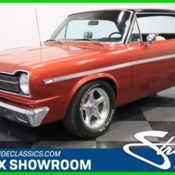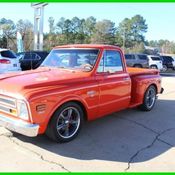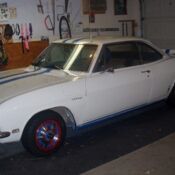1968 BMW R50US, R60US or R69US
| Condition: | Used |
| Make: | Other Makes |
| Trim: | Motorcycle |
| Year: | 1968 |
| Mileage: | 49358 |
| VIN: | 1815621 |
| Color: | Other |
| Engine: | VW Powerplant Swap |
| Transmission: | Manual |
| Interior color: | Other |
| Vehicle Title: | Clean |
| Extras |
| Listed by | Private seller |
Description of 1968 Other Makes Motorcycle |
|
Made in Munich, West Germany, BMW motorcycles of the 1960s were noted as long-distance touring motorcycles. This example is in fine overall shape and is a typical classic BMW motorcycle and includes a trailer. The VW motor conversion was professionally swapped and is an instant attention getter. Though BMW first used oil-damped telescopic front forks in the 1930s, it chose to use Earles forks on these models. The triangular front Earles fork, named after its designer, Englishman Ernest Earles, precluded any front-end dive during heavy front braking, which is common with telescopic front forks. It also worked well in sidecar duty. Though heavy and ponderous in turning, the Earles fork gave the old Beemer a steady and reassuring ride. In 1968, BMW introduced telescopic forks on some of its slash-2 models and they were continued into the 1969 model year. Earles fork and telescopic fork models both were manufactured for these two years and were available to customers. This model comes with a rarely seen transplanted VW powerplant, four-cylinder and air-cooled boxer engine and a four-speed, foot-shifted manual transmission. Gauges include an 8,000-rpm tachometer and there are dual sideview mirrors. During the 1960s, very few motorcycles were available with shaft final drive. BMWs were the most common. The driveshaft rode in an enclosed oil bath within the right swingarm, unlike BMWs previous models and drove the rear wheel through an internally splined cup that meshes with a coupler crown gear keyed to the drive pinion. This meant that leaking seals could become a problem for the owners. Because the clutch was dry, there were seals at the rear of the crankshaft, at both ends of the transmission, at the rear of the driveshaft and at the front and rear of the rear drive unit. The front brakes were double leading shoes, and the rear had a single leading shoe. By modern standards, they were not good brakes. Tires are Dunlop's D404Fs, size 100/90-16. They are mounted on wire wheels. Motorcycles sold in America had high handlebars with a cross brace. Those sold elsewhere came with low, Euro handlebars. U.S. motorcycles came standard with a narrow dual saddle, though wide dual saddles with chrome rear handles could be ordered. Solo saddles made by Pagusa or Denfeld for driver and passenger were also available. All motorcycles came with a tool kit. Hella turn signals were optional and were mounted at the ends of the handlebars showing light both forward and back. In the United States, all these Earles-fork and US-fork (i.e., telescopic fork) models from 1955 to 1969 are often lumped together as "Slash-2" BMWs, even though that is technically incorrect. Not all of them, as seen above, have the "/2" designation. No BMW motorcycle came standard with fairings or luggage; these items were provided by aftermarket vendors. Fairings included the Wixom Ranger handlebar-mounted fairing made in Illinois, and Avon. There were numerous manufacturers of saddle bags and top cases for BMW twins in the 1960s including Wixom, British-made Craven, and leather saddlebags imported by Butler and Smith, who also offered several styles of luggage carriers for mounting behinds the passenger saddle. It also offered several styles of windshields, safety bars, a spotlight, metric tool kits, and a mechanical tachometer. Perhaps the most famous BMW rider of the 1960s was Danny Liska, who took R60 models from Alaska to Tierra del Fuego in one trip, and from Europe's North Cape to South Africa's Cape of Good Hope in a second journey. His book about the first trip, Two Wheels to Adventure (Alaska to Argentina by Motorcycle), was published in 1989 with a second edition published in 2004. In the book "Zen and the Art of Motorcycle Maintenance," John and Sylvia Sutherland accompany Robert Pirsig, the author, and his son Chris, on a 1968 road trip from Minnesota to San Francisco, riding a BMW R60. Throughout the book Pirsig contrasts his passion and care in taking care of his bike to John's fear of technology: "The BMW is famous for not giving mechanical problems on the road and that's what he is counting on." Documents include a box of parts, a Clymer BMW service, repair and maintenance guide for 1955-1969 BMW motorcycles and a BMW Motorcycle Buyer's Guide. VIN: 1815621 This motorcycle is currently located at our facility in St. Louis, Missouri. Current mileage on the odometer shows 49,358 miles. It is sold as is, where is, on a clean and clear, mileage exempt title. GET OUT AND DRIVE!!! Note: Please see full terms and conditions listed below that pertain to the purchase of any said vehicle, thank you. |
 Home
Home Contact us
Contact us NEWEST CARS
NEWEST CARS SELL YOUR CAR
SELL YOUR CAR FAQ
FAQ















